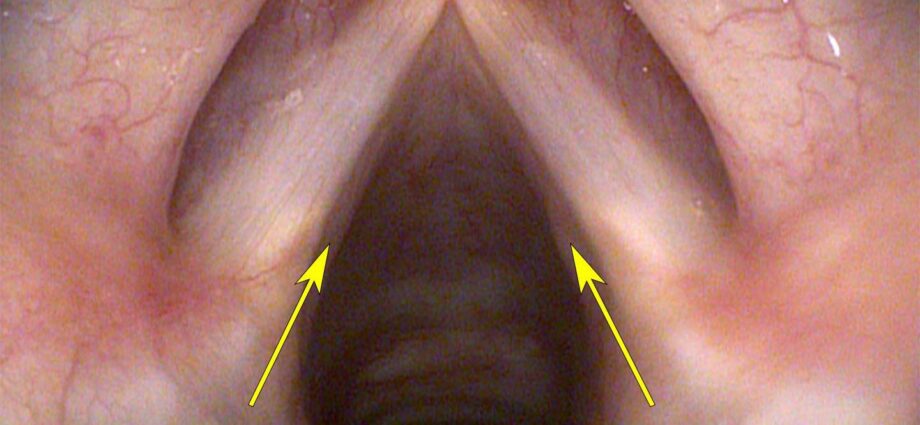Contents
Vocal cords
The vocal cords, or vocal folds, located at the level of the larynx, allow phonation.
Anatomy of the vocal cords
Position. Two in number, the vocal cords are located within the duct formed by the larynx (1). Within this duct, the vocal cords are located approximately 8mm from the lower edge of the thyroid cartilage (1). They extend from front to back, and form a V-shaped structure pointing forward.
- In the front, the vocal cords attach to the thyroid cartilage of the larynx.
- At the back, the vocal cords attach to the arytenoid cartilage, at the level of the vocal process.
Structure. The vocal cords are made up of several elements (1):
- The mucous membrane of the vocal cords is made up of an epithelium and a chorion. The latter has bundles forming the vocal ligament or lower thyro-arytenoid ligament.
- The vocal process is a cartilaginous structure used to fix the vocal ligament at the level of the arytenoid cartilage.
- The muscles of the vocal cords are the vocal muscle, located in the thickness of the vocal cords, as well as the crico-thyroid muscle. Made up of two bundles, the latter intervenes in the rocking movement of the arytenoid cartilages, thus allowing the tension of the vocal cords.
Innervation. The vocal cords have sympathetic, sensory and motor innervation. Sensory innervation is carried out by the superior laryngeal nerve. The vocal muscle and the crico-thyroid muscle are innervated by the recurrent laryngeal nerve and the external laryngeal nerve, respectively (1).
Functions of the vocal cords
Role in swallowing. In order to prevent the passage of food or fluids through the trachea and lungs, the epiglottis closes the larynx and the vocal cords come together (2).
Respiratory function. The epiglottis and vocal cords pass inhaled air to the trachea and lungs, and exhaled air to the pharynx (2).
Organ of speech. The sound of speech is emitted when exhaled air vibrates the vocal cords.
Vocal cord pathologies
Sore throat. In the majority of cases, they are of viral origin. In the case of laryngitis or epiglottitis, they may be linked to a bacterial infection.
Laryngitis. It corresponds to inflammation of the larynx, especially in the vocal cords. Acute or chronic, it can manifest as a cough and dysphonia (pathway disorders). It is more serious in children and may be accompanied by dyspnea (difficulty breathing) (3).
Vocal cord nodule. A nodule is a ball of tissue that can develop anywhere in the body, especially in the vocal cords. These are usually benign tumors, or cancer if the nodule turns out to be a lesion.
Cancer of the vocal cords. This type of cancer is usually associated with throat cancer (4).
Vocal cord treatments
Antibiotic or anti-inflammatory treatment. An antibiotic may be prescribed for a bacterial infection. Anti-inflammatory drugs may also be prescribed to limit inflammation.
Tracheotomy. In the most serious cases, this surgical intervention consists of an opening at the level of the larynx to allow the passage of air and prevent asphyxiation.
Laryngectomy. In the most severe cases of cancer, removal of the larynx may be performed (5).
Radiotherapy. Cancer cells are destroyed by exposure to x-rays (5).
Chemotherapy. Medicines can be given to limit the spread of cancer.
Vocal cord exams
Indirect laryngoscopy. It allows you to observe the larynx using a small mirror placed at the back of the throat (6).
Direct laryngoscopy. The larynx is studied using a rigid and flexible tube introduced through the nose. This intervention can also allow a sample to be taken (biopsy) if the examination requires it (6).
Laryngopharyngography. This x-ray examination of the larynx can be performed to complete the diagnosis (6).
History and symbolism of the vocal cords
The low position of the larynx in modern humans compared to other mammals was the subject of a theory on the origin of language. However, recent research suggests that the ability to speak is much older (7).










